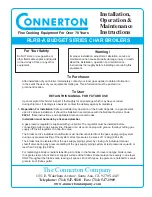
804546NZ - BW_HB Small_09.18 v1.02
Page 5 of 24
Screws or bolts must be capable of supporting the heater weight when filled.
Step 3 – Connecting
THE FOLLOWING PROCEDURE IS TO BE DONE BY AN AUTHORISED
INSTALLER ONLY.
3.1 Plumbing
For exposed plumbing connection, connect the cold water inlet pipe from the
base of the heater directly to the 12.7 mm compression fittings.
For concealed plumbing connections, connect the cold water pipe through
the rear of the chassis using a 12.7 mm capillary elbow (# 63 Swivel
Elbows).
Cold water pipes must be flushed before connection to the inlet. Any
clogging due to sediment or fines will adversely affect the operation of the
heater.
It is recommended that the heater be installed with a stop cock which allows
it to be isolated from the mains supply for servicing.
Water pressure requirements:
Minimum - 150 kPa; maximum - 700 kPa.
A 500 kPa pressure limiting valve is part of the Hydroboil water inlet
assembly.
3.2 Venting
A vent at the base of the heater must be plumbed to a safe visible location
as, under certain conditions, it may discharge cold or boiling water and/or
steam.
For exposed vent plumbing, connect vent outlet from the base of heater to
a 12.7 mm pipe which has a continuous fall, is no more than 3 metres long,
has no more than 3 right angle bends, and visibly discharges to a waste
water drain.
For concealed vent plumbing, connect plumbing to the vent outlet from the
heater rear using a elbow protruding 45 mm from the wall.
Alternatively attach a tundish to the wall as shown and plumb away to
waste.
Note: when routing the plumbing for the vent / tundish installed
and mains inlet line, ensure you do not obstruct filter access for
Remove Filter Guard
1
2
250mm
Wring
Concealed
Vent
Concealed
Inlet
45 mm
Visible Tundish
Vent line
Installation Procedures






































